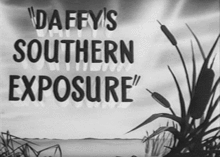Daffy's Southern Exposure
Daffy's Southern Exposure is a 1942 Warner Bros. Looney Tunes animated short directed by Norman McCabe.[1] The cartoon was released on May 2, 1942, and stars Daffy Duck.[2]
| Daffy's Southern Exposure | |
|---|---|
 Title card | |
| Directed by | Supervision: Norman McCabe |
| Produced by | Leon Schlesinger |
| Story by | Don Christensen |
| Starring | Mel Blanc (uncredited) |
| Music by | Musical Direction: Carl W. Stalling Orchestra: Milt Franklyn (uncredited) |
| Edited by | Treg Brown (uncredited) |
| Animation by | Vive Risto Uncredited animation: Cal Dalton I. Ellis John Carey |
| Layouts by | David Hilberman (uncredited) |
| Color process | Black-and-white (later redrawn/digitally colorized) |
Production company | |
| Distributed by | Warner Bros. Pictures |
Release date |
|
Running time | 7 minutes |
| Language | English |
The cartoon was later remade in color as five years later Along Came Daffy directed by Friz Freleng.[3]
Plot
Daffy Duck decides not to fly south for the winter, as he wants to "check up on this winter business" (gesturing to a newspaper he is reading, with a scantily-clad "snow queen" pictured.) All the other ducks tell him "You'll be sorry!", and continue flying south.
Daffy initially marvels at the snow and ice that mark Winter's arrival, but as the conditions become progressively worse, he begins to starve and gets stranded in a snowstorm. He takes refuge at the home of (unbeknownst to him) a fox and weasel, who are desperate for fresh meat to eat and are sick of drawing from their massive stockpile of beans. The two disguise themselves as kindly old ladies in order to keep Daffy in their home. They want Daffy for dinner, and so fatten him up by having him eat large portions of their stock of beans.
Once Daffy realizes their intentions, he quickly tries to escape, outwitting the weasel but not the fox. Daffy forces the fox to chase him up a tree so he can kick him down, then runs further south, past two signs pointing "SOUTH", and one more which reads "And we do mean SOUTH!"
Daffy ends up in South America. A samba dancer, who is a pastiche of Carmen Miranda, is seen singing in a nightclub, and Daffy is finally shown hiding in the dancer's fruit hat. Daffy, also wearing a fruit hat, emerges and says, "Si, si! I like the 'South' American Way. And I do mean SOUTH." Daffy winks at the audience before iris-out.
Production
Daffy's Southern Exposure makes reference to topical humor of the era, including a poster encouraging the purchases of war bonds to finance the U.S. involvement in World War II and a parody of the Brazilian entertainer Carmen Miranda[4]—one of her songs, "South American Way," is also referenced. The film also marked the first time that Warner Bros. used the tune wartime rally song "We Did It Before (And We Can Do It Again)" as background music in a cartoon.[5]
References
- Beck, Jerry; Friedwald, Will (1989). Looney Tunes and Merrie Melodies: A Complete Illustrated Guide to the Warner Bros. Cartoons. Henry Holt and Co. p. 127. ISBN 0-8050-0894-2.
- Lenburg, Jeff (1999). The Encyclopedia of Animated Cartoons. Checkmark Books. pp. 70–72. ISBN 0-8160-3831-7. Retrieved 6 June 2020.
- "Director Norman McCabe". ToonHeads. Season 7. Episode 11. December 28, 2002. Cartoon Network.
- Michael S. Shull, David E. Wilt (2004). Doing Their Bit: American Animated Short Films, 1939-1945. McFarland. p. 46. ISBN 0-7864-1555-X.
- M. Paul Holsinger (1999). War and American Popular Culture: A Historical Encyclopedia. Greenwood Publishing. p. 329. ISBN 0-313-29908-0.
External links
- Daffy's Southern Exposure at IMDb
- Daffy's Southern Exposure at The Big Cartoon DataBase
- Daffy's Southern Exposure (Colorized) on the Internet Archive
| Preceded by Conrad the Sailor |
Daffy Duck Cartoons 1942 |
Succeeded by The Impatient Patient |